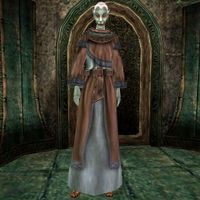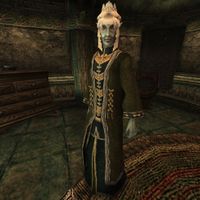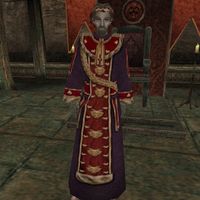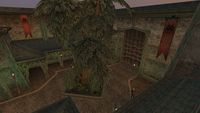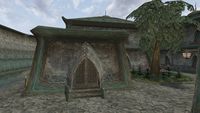Lore:Athyn Llethan
| King Athyn Llethan | |||
|---|---|---|---|
| Race | Dunmer | Gender | Male |
| Died | 3E 427 |
||
| Resided in | Morrowind | ||
| Reign | 3E 391- 3E 427 |
||
| Previous Ruler | Barenziah | ||
| Next Ruler | Helseth | ||
King Hlaalu Athyn Llethan was the Dunmer King of Morrowind in the late Third Era, serving as a regent while the longtime Queen, Barenziah was in exile.[1][2] One of his well-known decrees was when he revoked the Tribunal Temple's ban on trade and settlement of Vvardenfell in 3E 414, ushering in a flood of Imperial and House Dunmer colonists that expanded on old settlements and built new ones.[3] As the King of Morrowind, he was known under several titles, such as the Defender of the People and Law, Duke of Mournhold and Hlaalu Province, Grace of All Gods, High Councilor and Lord of Morrowind, and Loyal Servant of the Empire and Emperor.[4][5][6]
Contents
History[edit]
When Athyn Llethan was born is unknown, but he came from a very prestigious lineage as a noble of House Hlaalu. He was a descendant of Hlaalu Brevur,[UOL 1] thus tied to the Seventh Family,[8] Hlaalu Pasoroth, whose earnings as a master warrior helped the Great House earn its power,[9] and the Ra'athim Clan, the historical monarchy of Ebonheart, whose original house was absorbed into House Hlaalu.[10][UOL 2] At some point in time, he married Ravani Llethan but they never had any children.[7] His nephew was Talen Vandas, whom he treated like a son[11] and his neice was Barenziah,[1] daughter of Mournhold's rulers at the time of Tiber Septim's invasion[12][13] and later Queen of Morrowind for most of the Third Era.[1]
During the Imperial Simulacrum, Morrowind was in great upheaval, largely from the Arnesian War with Black Marsh. In 3E 391,[Note 1] a peasant uprising, organized by a few disgruntled nobles broke out in Mournhold, demanding that Barenziah's husband, Symmachus stepped down. And while Barenziah and her children were away in the Imperial City, Symmachus was slain in the revolt and the rebels took over the Kingdom of Mournhold.[Note 2] Barenziah, who feared for her life back home, fled with her children to the Kingdom of Wayrest in High Rock, where she married King Eadwyre and became the Queen of Wayrest. In her stead, Athyn Llethan became the King of Morrowind and took residence in the Royal Palace in central Mournhold.[1][2][10]
Unlike Barenziah, who was very much beloved by her people,[1][14] he was not received well and him and his court were despised by natives. The Dunmer never recognized a figurehead ruler like the Empire did.[7][UOL 1] There was an uneasy truce between the King, Temple, and House, and it started to crumble at the time of his ascension.[1] In 3E 414, King Llethan abolished Vvardenfell's status as a Temple preserve under the Armistice and allowed people across Morrowind and the Empire to settle it.[3] In 3E 418, King Eadwyre passed away from old age and the power struggle for Wayrest's throne between Barenziah's son Helseth and his step-sister, Elysana reached its climax. Helseth lost, so he and Barenziah returned to Morrowind in exile.[15][UOL 3]
Athyn Llethan welcomed them kindly[15] and although he was meant to rule Morrowind in her place,[2] Barenziah had no interest in resuming her reign and sought to retire to her family estates.[15] Athyn was old like Barenziah herself and he looked toward his nephew, Talen Vandas to succeed him after his death.[11] Until then, he resumed his usual role as King. In 3E 426, he imposed tariffs on the import and export of alcoholic beverages, such as native drinks like greef, shein, and sujamma, as well as flin, a Cyrodiilic whiskey. Houses Hlaalu and Redoran openly opposed these tariffs, at least on native drinks, so King Llethan granted reliefs to merchants.[6][16]
In 3E 427, King Athyn Llethan passed away and because of Talen Vandas' earlier death, the throne of Mournhold was passed to his great-nephew and Barenziah's son, Helseth.[1][7] Helseth lingered around Llethan's court since his return and rumors already spurred about his ambitions for the throne.[15] Talen Vandas died sometime between his return and his ascension, with the official statement being it was from a hunting trip.[17] The official cause of death for Llethan was old age, but many people including Ravani Llethan believed Helseth poisoned him. Even a newspaper called the Common Tongue led toward this idea by presenting Helseth's history of corruption and subterfuge.[18][19]
Fedris Hler, steward to Almalexia and leader of the High Ordinators believed most Dunmer in Mournhold knew that Helseth had the King killed, but did not speak up out of fear.[20] Though the public expressed some respects to Llethan's passing, they were generally indifferent to it, but still held suspicions to both his and Talen's death being timed right around Helseth's arrival to Mournhold.[7][21] Barenziah claimed that Athyn Llethan lived a rich and rewarding life.[22]
Gallery[edit]
Notes[edit]
References[edit]
- ^ a b c d e f g Pocket Guide to the Empire, 3rd Edition: The Temple: Morrowind — Imperial Geographical Society, 3E 432
- ^ a b c Biography of Barenziah, v 3 — Stern Gamboge, Imperial Scribe
- ^ a b A Short History of Morrowind — Jeanette Sitte
- ^ Tradehouse notice
- ^ Hospitality Papers — Muthsera Master Angaredhel; Mage-Lord
- ^ a b Red Book of 3E 426
- ^ a b c d e King Llethan's death generic dialogue in Morrowind: Tribunal
- ^ People of Morrowind — Various
- ^ Hallgerd's Tale — Tavi Dromio
- ^ a b The Real Barenziah, v 5 — Anonymous
- ^ a b Talen Vandas generic description in Morrowind: Tribunal
- ^ The Real Barenziah, v 1 — Anonymous
- ^ Biography of Barenziah, v 1 — Stern Gamboge, Imperial Scribe
- ^ The Real Barenziah, v 4 — Anonymous
- ^ a b c d A Game at Dinner — An Anonymous Spy
- ^ Yellow Book of 3E 426
- ^ King Hlaalu Helseth's dialogue in Morrowind: Tribunal
- ^ Ravani Llethan's dialogue in Morrowind: Tribunal
- ^ The Common Tongue
- ^ Fedris Hler's dialogue in Morrowind: Tribunal
- ^ Helseth generic description in Morrowind: Tribunal
- ^ Barenziah's dialogue in Morrowind: Tribunal
- ^ The Third Era Timeline — Jaspus Ignateous
- ^ The Daggerfall Chronicles — Ronald Wartow
- ^ Mournhold location and rumors in Arena
Note: The following references are considered to be unofficial sources. They are included to round off this article and may not be authoritative or conclusive.
- ^ a b Ken Rolston's Posts
- ^ Interview With Three Booksellers — Jobasha, Codus Callonus, and Dorisa Darvel
- ^ Ted Peterson's Posts in Campaign 7/The Evening Star Parade – Loranna's RP
